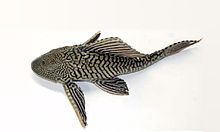Loricarioidea is a superfamily of catfishes (order Siluriformes). It contains the six families Trichomycteridae, Nematogenyiidae, Callichthyidae, Scoloplacidae, Astroblepidae, and Loricariidae. Some schemes also include Amphiliidae. This superfamily, including Amphiliidae, includes about 156 genera and 1,187 species.[2]
| Loricarioidea | |
|---|---|

| |
| Pterygoplichthys sp. | |
| Scientific classification | |
| Domain: | Eukaryota |
| Kingdom: | Animalia |
| Phylum: | Chordata |
| Class: | Actinopterygii |
| Order: | Siluriformes |
| Superfamily: | Loricarioidea Rafinesque, 1815 |
| Families | |
|
(Amphiliidae) | |
The earliest known fossils of Loricarioidea are of Corydoras revelatus from the Late Paleocene of Argentina, but molecular estimates suggest that the main radiation of the superfamily occurred during the Late Cretaceous.[3]
Taxonomy edit
Loricarioidea is traditionally considered a part of Siluroidei, a clade of all catfishes excluding Diplomystidae.[4] In Nelson, 2006, this grouping is sister to the superfamily Sisoroidea.[2] However, in a recent molecular analysis, it was determined that the suborder Loricarioidei (not including Amphiliidae) is sister to a group including Diplomystidae and Siluroidei. Amphiliidae, in this analysis, was found to be much more closely related to Mochokidae or Malapteruridae.[4] With the discovery of Afrocascudo in 2024, the fossil record of Loricariidae (and Siluriformes as a whole) extends back to the Cenomanian age of the Late Cretaceous in North Africa (Kem Kem Group), making loricarioids the basalmost superfamily of catfish.[1]
Loricarioidea is currently diagnosed by the derived presence of a reduced gas bladder, encapsulated in expansions of the parapophysis of the first vertebrae, and of odontodes, small dermal denticles.[5] Amphiliidae is the most basal group in Loricarioidea.[2] In some older sources, Amphiliidae is not even included in this classification.[6] Based on morphologically evidence, Trichomycteridae and Nematogenyiidae diverge first; these two families are probably sister groups.[2] This relationship was neither supported nor rejected by molecular evidence.[4] Next, the order of divergence is probably Callichthyidae, then Scoloplacidae, and then Astroblepidae and Loricariidae.[2][4] A trend in increasingly complex jaw morphology can be seen in this superfamily, which may have allowed for the great diversification of the Loricariidae, which have the most advanced jaws.[6]
Distribution and habitat edit
These fish are found in freshwater habitats in the Neotropics, inhabiting South America, Panama, and Costa Rica. Most species inhabit stream habitats or pools; water in these habitats tends to move relatively quickly.[6] Loricariids and Astroblepids have adapted to this with suckermouths that allow them to cling to surfaces. Astroblepids even have the ability to climb up waterfalls.[2]
Description edit
Like other catfish, loricarioidean catfish tend to have whiskers (except within the family Loricariidae). Fish in this group can be naked or, in the case of Callichthyids, Scoloplacids, and Loricariids, armored with bony plates.[2] Most loricarioid species are depressed (flattened) in body shape, though Callichthyids tend to be more compressed (thin).[6] Loricarioidea is defined by two characters. First, they have a unique, encapsulated gas bladder. Also, they have integumentary teeth called odontodes on their body and fin rays.[6] In Loricariids, these odontodes on their gill cover can be extended outwards.[6] Astroblepids may use their odontodes as a sensory organ.[7]
Ecology edit
Loricarioidea is a very diverse monophyletic group. These fish exhibit a wide range of morphologies and occupy many different habitats and trophic levels. This group includes herbivores, omnivores, and even parasites (candirú) and wood-eating species (Panaque).[6][8] Loricariidae is by far the most successful and diverse family with approximately 700 species (and new species being discovered each year), and is the most species-rich family in the entire order.[2]
References edit
- ^ a b Brito, P. M.; Dutheil, D. B.; Gueriau, P.; Keith, P.; Carnevale, G.; Britto, M.; Meunier, F. J.; Khalloufi, B.; King, A.; de Amorim, P. F.; Costa, W. J. E. M. (2024). "A saharan fossil and the dawn of Neotropical armoured catfishes in Gondwana". Gondwana Research. doi:10.1016/j.gr.2024.04.008.
- ^ a b c d e f g h Nelson, Joseph S. (2006). Fishes of the World. John Wiley & Sons, Inc. ISBN 0-471-25031-7.
- ^ Near, Thomas J; Thacker, Christine E (18 April 2024). "Phylogenetic classification of living and fossil ray-finned fishes (Actinopterygii)". Bulletin of the Peabody Museum of Natural History. 65. doi:10.3374/014.065.0101.
- ^ a b c d Sullivan, JP; Lundberg JG; Hardman M (2006). "A phylogenetic analysis of the major groups of catfishes (Teleostei: Siluriformes) using rag1 and rag2 nuclear gene sequences". Mol Phylogenet Evol. 41 (3): 636–62. doi:10.1016/j.ympev.2006.05.044. PMID 16876440.
- ^ Reis, Roberto E. (1998-05-14). "Callichthyidae. Armored Catfishes". Tree of Life Web Project. Retrieved 2007-07-04.
- ^ a b c d e f g Schaefer, Scott A.; Lauder, George V. (1986). "Historical Transformation of Functional Design: Evolutionary Morphology of Feeding Mechanisms in Loricarioid Catfishes". Systematic Zoology. 35 (4). Society of Systematic Biologists: 489–508. doi:10.2307/2413111. JSTOR 2413111.
- ^ Schaefer, Scott A.; Buitrago-Suárez, Uriel Angel (2002). "Odontode Morphology and Skin Surface Features of Andean Astroblepid Catfishes (Siluriformes, Astroblepidae)" (PDF). Journal of Morphology. 254 (2): 139–48. doi:10.1002/jmor.10024. PMID 12353298. S2CID 27019672254:139–148
{{cite journal}}: CS1 maint: postscript (link)[dead link] - ^ Nelson, J. A.; Wubah, D. A.; Whitmer, M. E.; Johnson, E. A.; Stewart, D. J. (1999). "Wood-eating catfishes of the genus Panaque: gut microflora and cellulolytic enzyme activities". Journal of Fish Biology. 54 (5): 1069–1082. doi:10.1111/j.1095-8649.1999.tb00858.x.